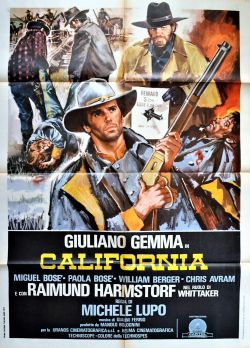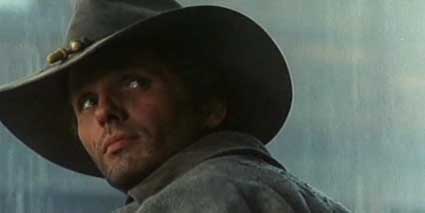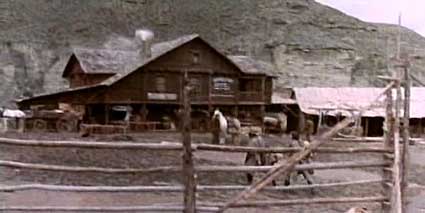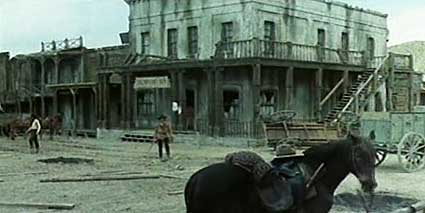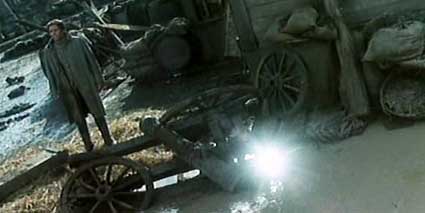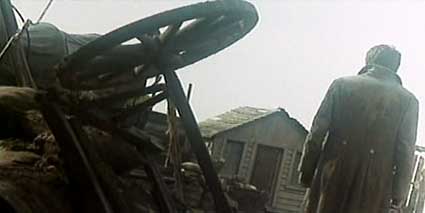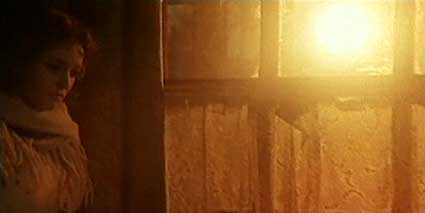California Film Review by J.D.
Review of California (1977);
By 1977, well over a decade old, the spaghetti western was drawing its final, dying breath, as most Italian filmgoers had moved on to horror and police dramas. After surviving the somewhat abysmal (yet somewhat profitable) comedy western period, the final so-called "twilight" westerns of this late period, although not the best the genre had to offer, gave us some solid, highly entertaining efforts, such as Castellari's Keoma, Fulci's Four of the Apocalypse, and Martino's Mannaja: A Man Called Blade. The twilight westerns I've seen all have something in common, in that they are usually very dark and cynical, as well as extremely violent, compared to earlier films. This, of course, was in part due to the declining condition of many of the film sets, but it also reflects, I believe, the cynicism of the times, as well as a subtle commentary on the state of the genre. Michele Lupo's 1977 effort, California, starring Giuliano Gemma, sticks to those conventions quite well, and makes for an entertaining, if somewhat flawed movie. Lupo, no stranger to the genre, gave us the decent Arizona Colt (also with Gemma), Ben and Charlie, and a few others.
Gemma stars as Michael "California" Random, a former Confederate soldier who finds himself with no particular place to go after being released from a POW camp at the end of the Civil War. He finds himself befriended by a young Georgian named Willie Preston (Miguel Bose) who is heading home to his family farm, but ends up deciding to join California instead. Meanwhile, we find that there's a group of rather ruthless bounty hunters led by the evil bastard Rupp Whittaker (Raimund Harmstorf), who are making a literal and financial killing hunting down ex-Confederate soldiers. Willie gets killed an incident where he gets into it with some Yankees and steals a horse, and so California decides to go to his family's farm and break them the news, where he ends up falling in love with Willie's sister, Helen (Paola Bose).
Of course, things very rarely end up happily ever after in these films, and of course, as the bounty hunters roll into town, raising more hell, California and Helen happen to be in town, and California is wounded in a shootout, as Helen is kidnapped and taken to Whittaker's hideout. California takes advantage of his anonymity and pulls off a robbery to gain Whittaker's trust with the hopes of finding his hideout and rescuing Helen, which he eventually does, as well as exact his revenge on Whittaker (their final fight contains some of the most brutal stuff I've ever seen in a spaghetti fight scene - let's just say you'll probably keep an eye out for trouble the next time you drink straight from the whiskey bottle).
Gemma, as in just about everything else I've seen him in, is fantastic. This was one of his few western roles where he played a darker, grittier character, as opposed to the "sunnyboy" (as a commenter in the SWDB forum put it) we usually see him in his films. There's a lot in this film for experienced spaghetti fans to keep an eye out for. In addition to the novelty of seeing our favorites (including William Berger, Claudio Undari and Dana Ghia) looking a bit older and grayer than we're used to, some of the sets from Once Upon a Time in the West were used, such as the easily recognizable Sweetwater set:
It also appears that a saloon scene was shot in the same set as the one where Harmonica meets Cheyenne. While we're on the subject of sets, it was downright jarring to see our beloved Tabernas set with its easily recognizable buildings that we've seen in hundreds of films, in such an obvious sorry state, looking as though it had been firebombed:
I can't help but wonder if some of the set devastation was genuine, not a fancy makeover, as it is a well-known fact that by this time, the sets were falling into a state of disrepair, due to less and less westerns being made. So much of what they show looks genuinely decrepit, not something as easily accomplished as smashing a few things and adding some paint.
The fight scenes in this film were some of the best I've ever seen in the genre. Brutal in their violence, I almost found myself ducking for cover several times while watching them. They were fighting as though they really wanted to kill each other, not your typical barroom brawlin'. Undoubtedly, Gemma's skill as an acrobat and stuntman contributed greatly to this. The picture is quite brutal in other ways, too, as some of the gunshots are quite gory. Not to dismiss the fine performances from its many actors, but the real star of this film is its look and atmosphere. In addition to the aforementioned rundown sets, it is all very gray, foggy, muddy and rainy, with few exceptions. Whether or not the desaturated look was a result of how it was shot or due to the age and condition of the print, I don't know, but everything looks incredibly dreary, and sets the mood through the entire film quite effectively.
I'd be remiss not to mention the stellar cinematography by Alejandro Ulloa, no stranger to the genre, with some twenty-one spaghettis on his resume. There were quite a few shots that were visually striking:
I love that kind of stuff, as it contributes to the mood and feel just as much as the action or dialogue, and separates the many mindless action films in the genre from those with some sort of true artistry.
Okay, I've gone on about it quite positively, haven't I? That's not to say this film is excellent by any means. I found Miguel Bose's character incredibly irritating, in that idiotic, naive dumb-kid kind of way, and wasn't exactly upset to see him killed. Also, there's not really a traditional story arc in this film. As others have pointed out, there's really three: a buddy-type film in the first third, a love story in the middle, and then a revenge theme in the last. That's not to say that it made for a bad film, but I found myself wondering about halfway through the film where exactly it was going, and what the plot was supposed to be, so it was a bit unfocused in that regard. All in all, I have to say I enjoyed it quite a bit, though, and can recommend it without reservation.
There are several releases of this on DVD out there, in various languages and quality. This was the New Entertainment World release from Germany, with German, Italian and English audio tracks. It looked decent enough, but from what I've heard, there doesn't seem to be any pristine release of this film currently available.
(You can read B.J.'s review on this site of California here)
This article is part of the A Fistful of Pasta archive
